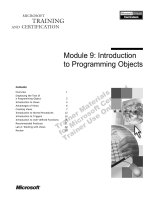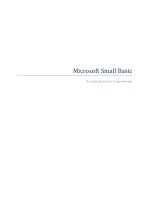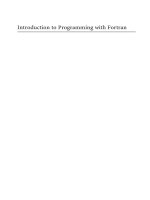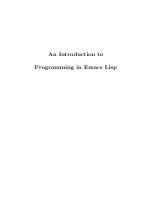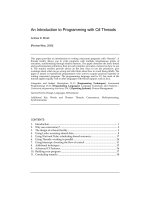Session 05 Introduction to Programming
Bạn đang xem bản rút gọn của tài liệu. Xem và tải ngay bản đầy đủ của tài liệu tại đây (146.4 KB, 22 trang )
LBC, Session 5
Loop
FPT APTECH COMPUTER EDUCATION HANOI
Objectives
•
•
•
•
Understand ‘for’ loop in ‘C’
Work with comma operator
Understand nested loops
Understand the ‘while’ loop and the
‘do-while’ loop
• Work with break and continue
statements
• Understand the exit() function
LBC/Session 5
2
What is a Loop?
Section of code in a program
which is executed repeatedly,
until a specific condition is
satisfied
LBC/Session 5
3
3 types of Loop Structures
The for loop
The while loop
The do….while loop
LBC/Session 5
4
The for loop-1
Syntax:
for(initialize counter; conditional test; re valuation)
{
statement
}
•The initialize counter is an assignment statement that
sets the loop control variable, before entering the loop
•The conditional test is a relational expression, which
determines, when the loop will exit
•The evaluation parameter defines how the loop control
variable changes, each time the loop is executed
LBC/Session 5
5
The for loop-2
• The three sections of the for loop
must be separated by a semicolon(;)
• The statement, which forms the body
of the loop, can either be a single
statement or a compound statement
• The for loop continues to execute as
long as the conditional test
evaluates to true. When the condition
becomes false, the program resumes on
the statement following the for loop
LBC/Session 5
6
The for loop-3
void main()
{
int count;
printf("\tThis is a \n");
for(count = 1; count <=6 ; count++){
printf("\n\t\t nice");
}
printf("\n\t\t world. \n");
}
LBC/Session 5
7
The Comma Operator
The scope of the for loop can be
extended by
including more than one
initializations or increment
expressions in the for loop
specification
The format is : exprn1 , exprn2 ;
LBC/Session 5
8
The Comma Operator
void main()
{
int i, j , max;
printf(“Please enter the maximum value \n”);
printf(“for which a table can be printed: “);
scanf(“%d”, &max);
for(i = 0 , j = max ; i <=max ; i++, j--)
printf(”%d+ %d = %d”,i, j, i + j);
}
LBC/Session 5
9
Nested for Loops-1
The for loop will be termed as a nested for
loop when it is written as follows
for(i = 1; i
//TODO:
for(j = 0; j < = max2; j++)
{
//TODO:
}
//TODO:
}
LBC/Session 5
10
Nested for Loops-2
void main()
{
int i, j, k;
i = 0;
printf("Enter no. of rows :");
scanf("%d", &i);
printf("\n");
for (j = 0; j < i ; j++)
{
printf("\n");
for (k = 0; k <= j; k++)
{
printf("*");
}
}
}
LBC/Session 5
11
The while Loop-1
Syntax:
while (condition is true){
statement ;
}
The while loop repeats statements while a certain
specified condition is True
LBC/Session 5
12
The while Loop-2
void main()
Example
{
int count = 1;
while( count <= 10)
{
printf(“\nIteration number %d\n”,count);
count++;
}
printf(“\n The loop is completed. \n”);
}
LBC/Session 5
13
do…while Loop-1
Syntax:
do{
statement;
} while (condition);
•In the do while loop the body of the code is executed
once before the test is performed
•When the condition becomes False in a do while the loop
will be terminated, and the control goes to the
statement that appears immediately after the while
statement
LBC/Session 5
14
do…while Loop-2
void main()
{
int num1, num2;
num2 = 0;
Example
do
{
printf( "\nEnter a number : ");
scanf(“%d”,&num1);
printf( " No. is %d",num1);
num2++;
} while (num1 != 0);
printf ("\nThe total numbers entered were %d",
--num2);
}
LBC/Session 5
15
Jump Statements-1
return expression;
•The return statement is used to return
from a function
•It causes execution to return to the
point at which the call to the function
was made
•The return statement can have a value
with it, which it returns to the program
LBC/Session 5
16
Jump Statements-2
goto label;
•The goto statement transfers control to any other
statement within the same function in a C program
•It actually violates the rules of a strictly
structured programming language
•They reduce program reliability and make program
difficult to maintain
LBC/Session 5
17
Jump Statements-3
Break;
•The break statement is used to terminate
acase in a switch statement
•It can also be used for abrupt termination
of a loop
•When the break statement is encountered in
a loop, the
loop is terminated
immediately and control is passed to the
statement following the loop
LBC/Session 5
18
Jump Statements-4
void main ()
{
break example
int count1, count2;
for(count1 = 1;count1 <=100; count1++)
{
printf("Enter %d count2 : ",count2);
scanf("%d", &count2);
if(count2==100)
break;
}
}
LBC/Session 5
19
Jump Statements-5
continue;
•The continue statement causes the
next iteration of the enclosing loop
to begin
•When this statement is encountered,
the remaining statements in the body
of the loop are skipped and the
control is passed on to the reinitialization step
LBC/Session 5
20
Jump Statements-6
void main()
{
Example
int num;
for(num = 1; num <=100; num++)
{
if(num % 9 == 0)
continue;
printf("%d\t",num);
}
}
LBC/Session 5
21
Jump Statements-7
exit(expression)
•The exit() is used to break out of
the program
•The use of this function causes
immediate termination of the program
and control rests in the hands of the
operating system
LBC/Session 5
22
